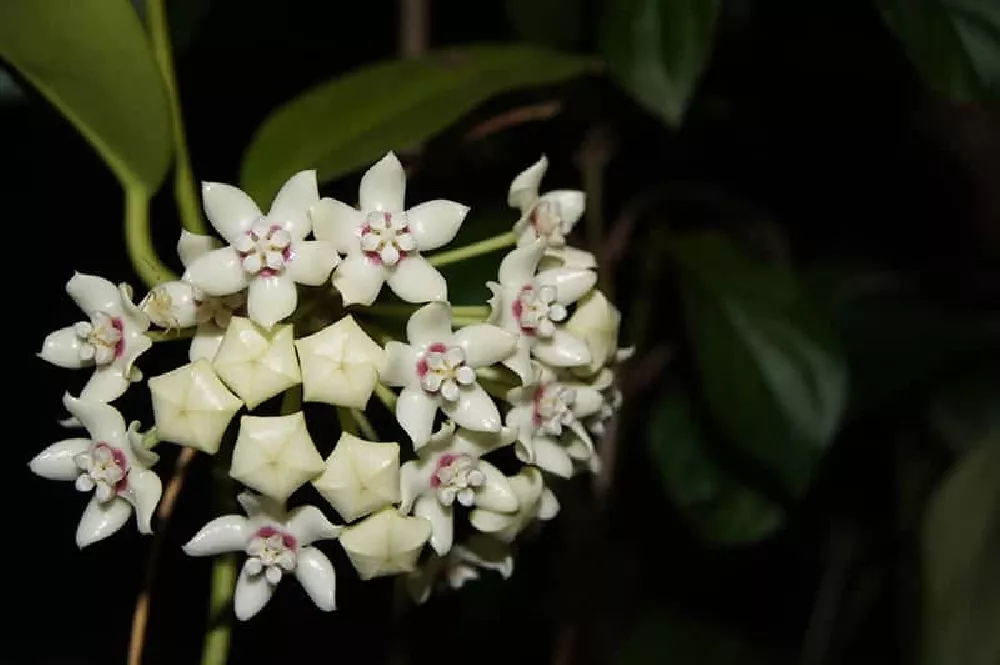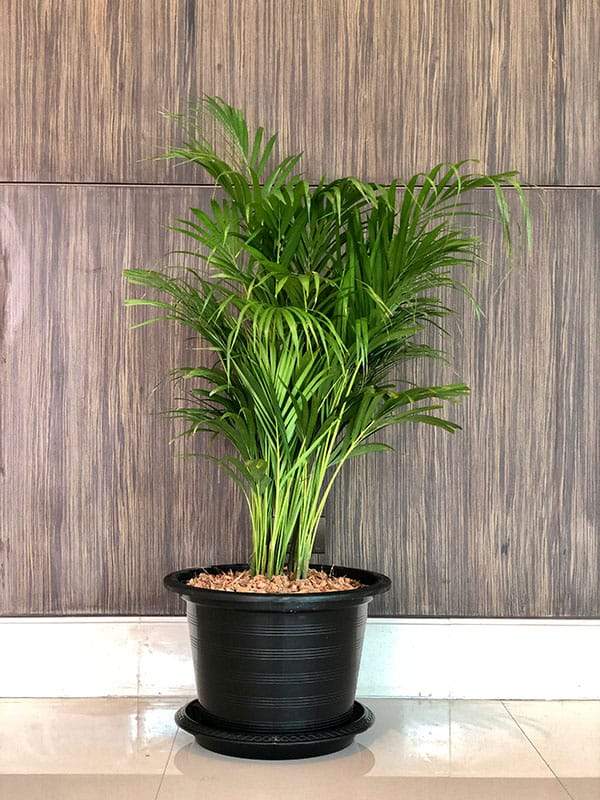- Home >
- Hoya Plants
Hoya Plants for Sale - Buying & Growing Guide
1 Results
Planting and Care
Planting instructions
Both mature plants and stem cuttings do well under artificial grow lights or bright, indirect light and will survive direct sun as long as it isn’t too hot. Most hoya plants will tolerate low light as well, though insufficient light will slow its growth further. If you’re hoping for blooms from a mature plant that is kept indoors, it will need bright exposure.
Though the hoya originates from a tropical environment and typically prefers a humid growing condition, those growing hoya plants indoors should consider placing a humidifier in the same room or misting the leaves occasionally to mimic the conditions these plants love. With enough humidity, hoyas can thrive in standard indoor temperatures between 65 and 80 degrees as long as it is kept away from drafts and direct airflow from an air conditioner or heating vent.
The hoya generally does better and blooms more frequently when it is potbound, so there is no need to repot more than every four or five years. Use a good-quality potting mix that drains well — a cactus or succulent mix is perfect — and keep your plant in a pot that has drainage holes, making sure to empty the drainage tray to avoid root rot.
Watering and nutrients
You should water most hoya plants about once per week during the growing season. When the soil becomes dry to the touch, that is when this plant needs a drink. During dormant phases, such as winter, you can reduce your watering significantly.
Hoya plants can be vulnerable to root rot. Water only when the top inch or so of soil is dry, making sure to use room temperature water to avoid shocking the plant. Empty your drainage tray after watering, and don’t saturate the plant.
The fertilizer you use for your hoya plant depends on your goals. If you want to encourage foliage growth in your hoya plant, then you should use a nitrogen-rich fertilizer. Those who wish to promote flowering will need fertilizers that contain more phosphorus.
Propagation
The ease of propagating hoya plants is made evident by the sale of single-leaf cuttings. To propagate your own mature hoya, cut a 3” stem tip cutting in the spring, cutting just below a node, which is where the roots will grow from. Make sure that your cutting contains at least one pair of leaves and place it either in water with the node below the water level or in a moist potting mix with the node above the soil level.
Pruning
Though the hoya is a slow-growing plant, mature plants can benefit from pruning to control their size or make it more aesthetically appealing. Careful pruning to take out dead growth will make your plant look healthier, and clipping the tips of a vine or two will make your plant grow back in a bushier shape. Ideal pruning times can vary depending on the hoya variety you own. However, it is generally best to prune during active growth in the spring and summer.
Pests, diseases, and animals
Like many indoor plants, hoyas are vulnerable to mealybugs, scale, and aphids. Wipe or rinse them off with water and, if needed, treat scale and aphids with neem oil or mild dish detergent and warm water.
Light
The Hoya plant enjoys bright indirect light. It will thrive in sunny spots where the light is filtered through sheer curtains. In fall and winter, the Hoya plant may live on a bright windowsill in direct sunlight, but it should be kept out of direct sunlight in spring and summer when the rays are stronger, especially in the heat of the afternoon, as this can cause the foliage to scorch or fade. If you want your Hoya plant to flower, then you need to position it in a spot where it will get as much bright, indirect light as possible, at least around six hours a day. If the plant isn’t getting enough light, then it will struggle to bloom.
Temperature
As a tropical plant, this plant can tolerate quite hot temperatures and is well suited to life indoors, where conditions tend to be warm. As a general rule, if you are comfortable with the temperature in your home, then your Hoya plant is comfortable too. The ideal temperature will differ depending on the variety of Hoya plant, but most can cope just fine with temperatures ranging from 50° F to 95° F. The perfect temperature for most Hoya varieties is between 60° F and 70° F.
As a heat-loving plant, the Hoya does well in sunrooms and conservatories, as long as it is given some shade during the heat of the day. Don’t let your Hoya plant live in an unused area of your home, such as a spare room, where temperatures may drop too low during winter months if you don’t heat up that room. In conditions lower than 50° F, the Hoya plant will likely lose its leaves. Keep it away from cold drafts, such as near windows, doors, and air conditioning units, to prevent sudden changes in temperature.
Humidity
This plant does well in moderate to high humidity and should fare well in the normal humidity found in homes. Keep it away from heaters and anything that may dry it out. If you notice that your plant seems to be suffering as a result of dry air, you can increase the humidity around the plant. There are several ways you can do this, including using an electric humidifier. Other methods you can use are simply spraying the plant with a water mist every couple of days or placing it on a pebble tray filled with water (Gardeners World Magazine). If you use a pebble tray, make sure the plant’s pot with holes in the bottom are not coming into contact with the water in the tray, as this will make its roots too wet and soggy.
Repotting
Hoya plants, similarly to orchids, perform best when their pot is a snug fit, so don’t be too keen to repot your Hoya plant. Leaving it until it becomes root-bound will actually result in a better bloom of flowers, so you shouldn’t be repotting this plant very frequently.
However, a time will come when the plant outgrows its pot and leaving it in such tight conditions can stunt its growth. At this point, it’s time to repot. If your Hoya is in a plastic pot, you can gently squeeze the sides of the pot to find out if it needs to be potted on. If there is give in the pot when you push the sides in, then the plant can remain in the pot. If the pot stays firm, then it means the roots are compacted and need some growing room.
Repot the plant during spring by selecting a pot just one or two inches wider and deeper than the Hoya’s current pot. Using a pot that is too big for this plant can cause growth problems, as too much moisture in the new soil can overwhelm the roots and prevent flowering.
Other Hoya Plant Varieties
It is estimated that there are several hundred varieties of the Hoya plant in existence, with more cultivars existing in some of the varieties. This means that there should easily be a variety of Hoya to suit everyone. Most varieties are grown for their flowers, though some are more of a vining plant, appreciated for their succulent foliage. You can also select your Hoya based on its needs, as different varieties like different climates, so you can find one that will grow perfectly in your home. A small snapshot of some of the varieties of Hoya plant is listed below.
Hoya Australis
Native to Australia, this variety is one of the few Hoyas that worships the sun and can tolerate it directly all year round. It grows in the wild around the edge of rainforests and is known for its ability to attract butterflies. As a houseplant, this is most commonly seen in Australia, though it is starting to be brought to other parts of the world. With its juicy succulent-like foliage and white and pink flowers, it is a very attractive Hoya.
Hoya Carnosa
This award-winning plant is what most people bring to mind when they think of Hoya. It is the most popular and most commonly found variety of Hoya, native to Australia and Eastern Asia. Many cultivars of this variety exist, all of them producing waxy leaves and star-shaped flowers in an array of colors. The stand out element of this variety is the fragrant blooms, which smell especially sweet in the evening. If you are looking for a Hoya Carnosa plant to add pleasure to your house, I would recommend getting a Hoya Carnosa ‘Compacta’, also called Hindu Rope Plant. This is a popular Hoya Carnosa plant type that you can easily find on the market.
Hoya Serpens
This variety of Hoya, native to the Himalayas, produces unusual-looking flowers. Though its blooms are the typical star shape associated with Hoya plants, they have a fuzzy, almost bristle-like texture and seem to be a cross between a flower and a nettle. The blooms are always a very pale green, with the central star being white or cream. The only vibrant color on this variety is a small spot of pink found at the middle of each flower. While the flowers on this variety may be somewhat underwhelming, the foliage is lush and abundant. The waxy green leaves of this Hoya plant are round in shape and grow rapidly along the extending vines.
Hoya Cinnamomifolia
This plant has been named cinnamomifolia due to the similarity between its leaves and those of the Ceylon cinnamon plant. It originates from Java, an Indonesian island. This variety is rarely grown as a houseplant, which is a shame because its blooms are very intriguing. The outer part of the flowers are usually a pale green or yellow, while the central star-shaped part of the flower is a very deep and rich shade of pink or red.
FAQs
Are hoyas poisonous?
One of the best aspects of the most popular hoya plant varieties is that they are non-toxic. Unlike other common indoor plants, hoyas do not cause serious symptoms or health hazards to pets that ingest them. Hoya plants are equally safe for humans as well.
What can I do to make my mature Hoya heart bloom?
At times, it can be difficult to get a hoya plant to bloom. But supplying yours with the ideal growth conditions gives you the best opportunity for success. One common reason for a hoya plant to fail to bloom is insufficient light. While these plants can live in low light conditions, they need enough light to develop healthy flowers. Altering your fertilization routine is another way to promote more blooms. Phosphorus, for example, is particularly helpful for boosting flower output.


